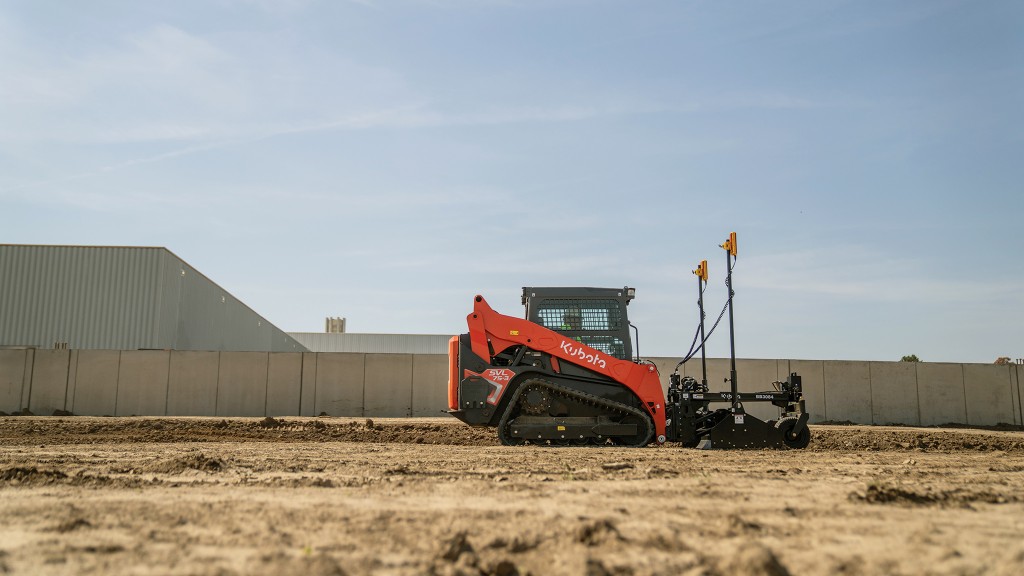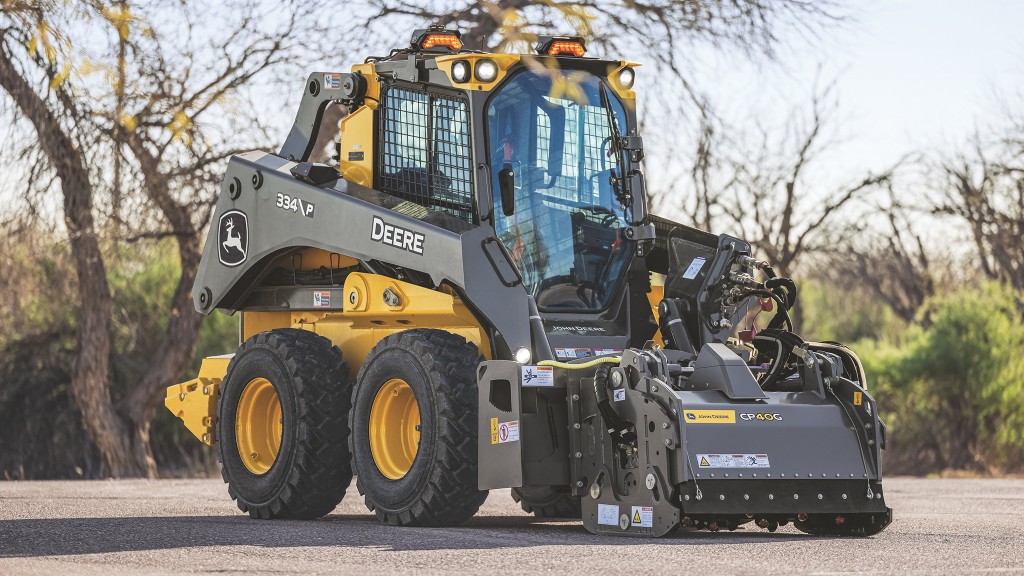How to spec your CTL for site prep success
Clear brush, grade, move materials & more with one machine

Site preparation and land clearing for projects, such as new housing developments, can involve a variety of tasks throughout the site development process. A compact track loader can arrive on site ready to remove brush, unload and load materials, grade, clear snow, and more. Jonathan Gardner, who is a product manager for Kubota Canada and has 9 years of experience in the industry, acknowledges that while plenty of contractors would love a big dozer to just push the material and get a site prep job done fast, CTLs are often the more practical solution. They are easier to maneuver and easier to trailer to and from the job site, and the versatility of the CTL's attachment options empowers operators to do more than just move dirt – provided that the CTL is correctly spec'd to maximize that potential.
Right-size your CTL to maximize efficiency
Once you know that a CTL is the right machine, there are several factors to consider for right-sizing your CTL selection, starting with the materials you'll be lifting, how much space you have for the CTL to maneuver, and how much material you want to move at once in pushing tasks, such as grading.
How much do you want to lift?
Consider lift capacity and rated operating capacity. Gardner recommends that you not only know what you'll be lifting and how often, but also how efficient you want to be when moving those materials. Whether you need to regularly lift two pallets of bricks at a time, or whether you only need to lift one, for example, will determine whether to size up your machine's lifting capacity. Vertical lift and radial lift configurations are both available on CTLs, but Kubota now only offers machines with a vertical lift configuration. In the past, radial lift machines offered more breakout force in ground engaging applications, but Gardner says that for larger machines the height provided by a vertical lift configuration is essential and advances in engineering have closed the gap between radial and vertical machines in breakout force.
What are the job site ground conditions?
The footprint that you have to move those materials in could matter as well. Often the length of the machine is overlooked when selecting a CTL for size, says Gardner. But if you're doing a lot of spinning, the length of the CTL could matter, and he notes that Kubota has customers who choose a smaller machine, even if its length is shorter by only three inches, because they're doing a lot of turning and those three inches make a big difference.
CTLs can be outfitted with a variety of track widths as well. While a wider track will offer greater flotation, if your CTL is going to be used in the winter to clean up snow on the job site, you will want narrower tracks to increase the ground pressure for better pushing power and traction.
How much do you want to push?
If you're grading for a long pathway a lot of material can build up. Smaller horsepower CTLs will have less power to push all that material than their higher horsepower counterparts – the operator will have to feather the material out more.
"A 65-hp machine might only be able to handle anywhere from a 72- to 84-inch-width box blade, while a 95-hp machine can handle an 8-foot-wide box blade. Even though you're doing fine grading, the 65 just doesn't have the power to keep going," says Gardner.
However, he adds that a lot of customers want to avoid larger engines that need diesel exhaust fluid and opt to buy machines that are 75 hp or under. "A lot of people went with the SVL 75 instead of the 97 because they didn't want to have to add diesel exhaust fluid, so they gave up more horsepower for that reason," Gardner says.
But there's another tradeoff if you select the smaller machine. "A 75-hp machine won't run a 40-gpm attachment," warns Gardner. "There's a formula where horsepower and flow gives you the output of what horsepower is left. So if you're running 40 gpm and you have a 95-hp machine, you're not left with much horsepower because you're using most of that horsepower to run the attachment."
Higher horsepower is essential if your machine is going to be clearing brush or snow with powered attachments such as mulchers and snowblowers.
Maximize your CTL's utilization with attachments
CTLs working in land clearing and site prep applications can be outfitted with forestry attachments, pallet forks, ground clean-up tools, grading attachments, and more. Choosing the right hydraulics option for the attachments that you want to use can make a big difference to that attachment's productivity.
Open centre vs. closed centre hydraulics
There are two hydraulic flow configurations to choose from when selecting a CTL: open centre and closed centre hydraulics. Gardner says that simultaneous function is better on machines with closed centre hydraulics, as the loader arms have their own circuit. On a closed centre machine, the attachment and the arms use the same circuit which prioritizes loader arms, then the bucket, then auxiliary functions.
To demonstrate the advantage of closed centre hydraulics, Gardner offers up the example of a mulcher – an attachment that is going to be functioning as the operator moves the loader arms up and down. The operator is going to have much better function if that machine has closed centre hydraulics. Open centre will work, but it won't be as efficient.
Closed centre hydraulics also give the operator more flexibility for adjusting the attachment. On a machine with open centre hydraulics, the options are either high flow or standard flow. With closed centre hydraulics, the operator can adjust the machine hydraulics to match the attachment flow for optimal performance of that attachment.
Bigger CTLs tend to be configured with closed centre hydraulics, but Gardner adds that some smaller machines are starting to get them too.
A box blade with grade control gives a CTL precision capability
The range of attachments for use in site preparation and land clearing is extensive, but there's one in particular that Gardner is excited about – pairing a box blade attachment with grade control technology. He doesn't believe that this attachment/technology is given enough consideration by CTL owners. Motor graders and dozers are too big for many grading applications, but a CTL can come into a job site, such as a new housing development, with a box blade and grading system to get that work done. And, as housing developments in urban areas get tighter, Gardner expects contractors will take more advantage of their CTLs' grading capability.
Kubota Canada offers the BB30 Series box blades for skid-steer and compact track loaders, which is compatible with third party laser/2D or GPS/3D control systems. Kubota Canada offers the Trimble Earthworks GO! attachment system for high-accuracy 2D grading that improves operator performance and reduces rework. The operator just brings their own device, iOS or Android, to interface with the Trimble system in the cab.
"I'm a firm believer in grade control and how it can take that novice operator and make them an expert. In the past, grade control was so expensive and it was either the price of the machine or three-quarters the price of the machine and people couldn't make that justification," Gardner says. "You don't need the 3D systems to build roads and housing developments, and to do tennis courts, sports facilities, and pathways all you need is 2D." HEG
Maintain your CTL attachments for optimal efficiency, longevity & job site safety
The acquisition of new attachments can save you time and diversify the capability of your CTL, but proper care is essential, not only for ensuring the longevity of your investment, but also for the safety of your operators and other ground crew on the job site. These maintenance tips can help you get the most out of your attachments while avoiding downtime and promoting job site safety.
Look for cracks in attachment frames or worn out teeth on buckets
Gardner says you can prolong your bucket life by replacing the cutting edge more, and damaged attachments are dangerous on the job site. If your pallet forks are damaged, for example, and you drop a load, workers on the ground can be seriously injured. Operators should take a few seconds to visually inspect attachments before starting work – it's a small task for essential peace of mind.
Regularly grease powered attachments
Any powered attachment with moving parts should be greased on a regular basis. This will significantly increase the life of your attachment.
Check hydraulic lines
Visually check your hydraulic lines. Broken lines can put the attachment out of commission, but more importantly are very dangerous on the job site. If a line burst during operation, hot hydraulic fluid can spray on workers, so line inspection should always be taken seriously.
Don't put a high flow through a standard flow attachment
Operators need to know their hydraulic attachments. Gardner says that Kubota's high-flow machines are very popular, but there aren't too many high-flow attachments. Operators need to know which of their hydraulic attachments require high-flow and which ones require standard flow. It is essential that high-flow attachments aren't used with the standard flow attachments – the attachment can break and require repair.



